Outfield Fly Rule’s prospect aficionado Andy Harris released his Mid-Season Top 30 Prospect Update on Monday. If you haven’t had a chance to review the updated prospect list or his “Get to Know a Prospect” series, it’s a great analysis of what the Atlanta Braves farm system has to offer, and that is quite a lot. Click the links to check them out:
It’s an exciting time to follow the Braves farm teams as the organization not only has significantly increased the depth and quality of players throughout the system, but also is now seeing many of the players move into the upper levels of the minor leagues and start to trickle into Atlanta. There’s an energy in Braves nation as fans are sensing the team is nearing the tipping point where that trickle turns into a steady stream of prospects pouring into SunTrust Park as regulars (or as parts of trades for regulars). More importantly, this momentum is expected to return the Braves to their glory days of perennial contention. So expectations are high and fans are, let’s call it “impatiently excited.”
As we look at the prospects in this context, I (OFR contributor Micah Smith) decided to dig into the prospect list and ask Andy Harris some specific questions in order to help us better understand what’s happening on the farm and what we have to look forward to.
Follow along with our discussion here, and then join in with your own questions on Outfield Fly Rule’s Facebook page:
Micah Smith: The last two years, the Braves saw two extremely young international prospects really energize the fan base by quickly rising from obscure signings to top prospects tearing up advanced pitching. I’m specifically referring to the top two prospects on your list, 20-year-old Ozzie Albies (2013, $350,000 signing bonus) and 19-year-old Ronald Acuna (2014, $100,000 signing bonus). Obviously, everyone expects Kevin Maitan (already ranked 6th) to be the next fast riser from the international class, but he’s the least obscure international signing the Braves have ever made. So outside of Maitan, is there anyone else in the large pool of talent brought in through the 2015 or 2016 international signing classes who you think might be the next Albies and Acuna?
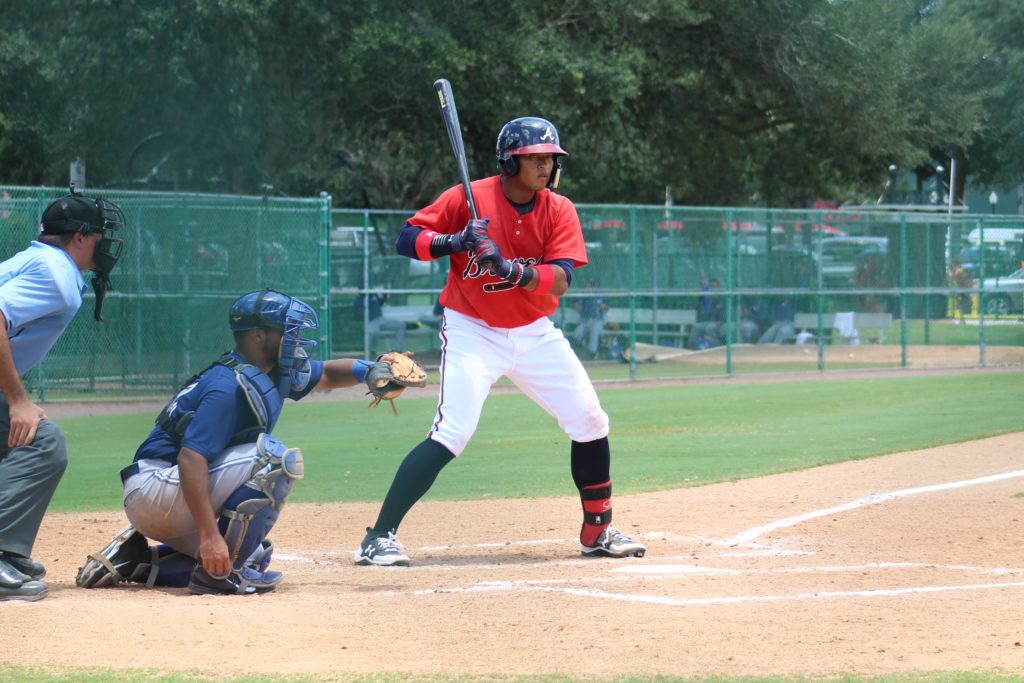
Andy Harris: You are right in that Maitan was clearly the creme of the crop of the international class. He certainly could rise to the level of Albies and Acuna, though he’s a very different player, a true slugger that at least for now can play in the middle infield, though I think he will be a third baseman long term. Of the rest of the recent international signings, I still like Cristian Pache from the 2015 class. He’s a guy I’m starting to think of as a right-handed Ender Inciarte, someone who could be a real difference-maker in the field and a spark-plug in the line-up. Late in that same class, the Braves signed catcher William Contreras out of Venezuela, the brother of Cubs catcher Willson Contreras. I think our Contreras has the potential to be better than his older brother, and is certainly more advanced at this stage in his development, especially defensively.
I’m also very excited about Yunior Severino. He’s got a very good hitting approach for a kid so young, an exciting patience/power mix. Then there’s some guys that fell just off my list, catcher Abraham Gutierrez and third baseman Juan Carlos Encarnacion. Gutierrez already shows as above average behind the plate and has a projectionable body for power down the road. Encarnacion hasn’t gotten as much press, signing late in the last international signing period, but he’s got a very interesting power bat and a big arm for third base.
That all said, it would be crazy to say any of them besides Maitan will be an Acuna or an Albies, a consensus top 20 prospect in baseball before the age of 20.
Micah Smith: That is a deep international class that excites me a lot, but one of the first things that stuck out to me from your prospect list is that you have seven pitchers in the top 10 and 10 pitchers in the top 15. Based on the Braves pitcher-first philosophy and the need to fill 5-man rotations and bullpens, this isn’t shocking, but it is a very deep area for the Braves. Six of these pitchers were included in a pretty tightly packed group in Baseball America’s midseason top 100 prospects in all of baseball: Kolby Allard (3 OFR, 22 BA), Mike Soroka (4 OFR, 33 BA), Kyle Wright (5 OFR, 41 BA), Sean Newcomb (7 OFR, 42 BA), Luiz Gohora (8 OFR, 76 BA), and Ian Anderson (9 OFR, 55 BA). Based on this I have a series of questions:
- Which one of these six starters do you think has the best chance to become the elusive “ace”? Why?
Andy Harris: Well Micah, using this very well-thought out method for identifying “aces” as a guide I would have to say Allard would be the most likely. He’s almost like the Goldilocks pitcher of the group. Soroka has the advanced feel for the craft, but Allard isn’t far behind. Wright has the three-plus-pitches arsenal, but Allard isn’t far behind. Newcomb (curveball) and Gohara (slider) each have a single devastating breaking ball they can turn to when they have to punch someone out, but Allard isn’t far behind (curveball). Anderson would actually probably be my second choice, but Allard is 19 and pitching well at AA, while Anderson is 18 and hitting some rough spots in low A.
The truth is though that even with this amazing group of pitchers, it’s still a bit of a crapshoot. Health is the biggest wildcard of course, but even if all goes well, “ace” is an elusive thing. I’m of the opinion that there’s only a handful of true aces in the game, and I can’t in good conscious point to a 19-year-old throwing in his first true full season of pro ball in AA Mississippi and pronounce “this guy will be Clayton Kershaw.”
- Beyond your wisdom in referencing my methodology in determining an ace, you also demonstrate wisdom in not setting a player up with an oft too lofty player comp since we fans tend to react very negatively to players falling short of that superstar comp and “only” being “good” MLB pitchers/hitters. In spite of that, I’m going to put you on the “hot seat” again with another question sure to rile someone up: Which of these six would you be most willing to leverage in a trade? Why?
Andy Harris: Anyone can and should be able to be had for the right return of course, but I believe Coppolella is correct in amassing the amount pitching he has. But if we were really to do a Chris Sale-type trade and we could use one of these pitchers as a bargaining chip, I would probably go with Newcomb. Even though he’s now a big leaguer and has seen some success, I think the Braves are more likely to be able to leverage that fact in a trade than try to talk up pitchers lower in the organization.
- Yep, that’s a fan riling response alright considering his hot start already has people enamored with him…which you astutely note would work to Coppy’s advantage in a trade. Now for a question that shouldn’t get you in trouble: Looking at those in that second group of pitchers in the top 15 who fall outside of the Top 100 prospects in baseball – Touki Toussaint (10), Joey Wentz (12), Bryse Wilson (13), and Max Fried (15) – which do you think has the best chance to make a big move up the list in the second half?
Andy Harris: I really can’t see Wentz or Wilson pitching better than they did in the first half (but it would be fantastic if they did), and Toussaint is already pretty high on my list, so I’ll go with Max Fried on this one. Watching him pitch in the first half has been maddening because everyone has seen him be dominant, and even in the first half he would go through stretches where he would mow batters down only to be undone by an inning or two where nothing goes right. It’s somewhat reminiscent of Newcomb last season, except Fried is getting hit a little harder. I had Fried at #8 on my preseason list, and he could certainly approach that again if he can start dropping that curve in for strikes, keep his fastball from getting so much of the plate, and use his change-up more effectively against right-handers, who have really hurt him in the first half.
Micah Smith: Fried is a conundrum. I’ve noticed that big talent and inconsistent performance and see the Newcomb link, though Newcomb seemed to struggle with consistency game to game while Fried seemingly does his Jekyll and Hyde impersonation inning to inning. But enough about pitching for a minute. It seems the Braves like to frustrate their fans by only caring about pitching when that’s only half the equation. Fans often give the team a hard time for always selecting pitchers in the draft, wringing their hands as they cry out, “We need bats!” And looking at only the draft, there’s some truth to this. The Braves selected pitchers with the first pick in all three drafts since the rebuild began. And it didn’t stop at first pick, looking at the first five picks in each of the past three drafts, 10 of those 15 selections have been pitchers! However, that “only care about pitching” trope is misleading. When looking at your top 30 prospect list, it seems more balanced with high quality bats than it did just a few years ago when less complete players like Christian Bethancourt, Jose Peraza and Tommy La Stella headed the list of position players. How have the Braves managed to develop these quality positional prospects while focusing so heavily on pitching at the top of the draft?
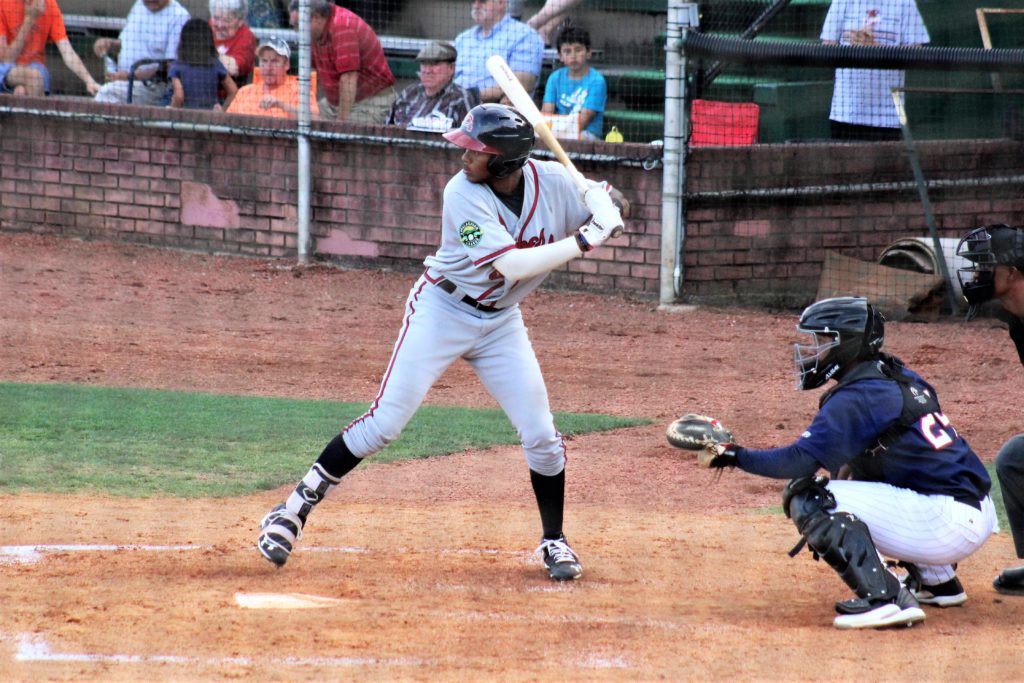
Andy Harris: First of all, the international scouting director from the Frank Wren era, Johnny Almaraz, was really good at his job. He was only with the Braves organization for three years, but in that time he opened an international pipeline the likes the Braves hadn’t had before. While Bethancourt didn’t work out and Peraza was moved in an ill-conceived trade, he brought into the organization Albies, Acuna, Juan Yepez (who the Braves have turned into Matt Adams), and a couple of more under-the-radar talents currently in Danville, Isranel Wilson and Shean Michel. So the nucleus of the current crop of position player prospects were there when the rebuild started, but none of them had gotten onto many prospects lists.
When the rebuild started and those high-profile trades started happening, the top players coming back were all pitchers, but almost all of the trades had a hitting component too. The big name in the Justin Upton trade was Max Fried, but we also got Dustin Peterson in that trade. We got Mike Foltynewicz in the Evan Gattis trade, but we also got Rio Ruiz. Matt Wisler was the top prospect coming back from the Craig Kimbrel deal, but an unsung part of that deal was the compensation draft pick we got from the Padres that the Braves turned into Austin Riley.
But obviously the biggest boost to the position player crop has been the signings by international scouting director Marc Russo and special assistant Gordon Blakeley. Maitan, Pache, Severino, and Contreras are their signings, along with a slew of young hitters that didn’t quite make the top 30 but would be on almost any other team’s top 30. Having that pipeline has has allowed the Braves to really go after high-ceiling pitching talent in the draft and still have a balance of talent in the system.
Micah Smith: That really makes me appreciate just how long it takes for talent to pool up and replenish a dry system, and just how well Coppy and Hart (and Wren, who apparently isn’t completely the dark Lord after all) have done at moving that process along. Digging deeper into the hitting side of the system, these guys have to fill eight positions. So which positions are especially deep and which positions are especially shallow?
Andy Harris: At the upper levels, I think you’d have to feel best about the infielders. Ozzie Albies and Rio Ruiz should both be regular faces in Atlanta shortly, and Johan Camargo just barely got enough major league service time to matriculate off the list. And lost in the hub-bub of Ronald Acuna‘s promotion to AAA is Austin Riley‘s move up to AA. I know some folks were questioning this move since his numbers at high-A Florida were just “OK”, but when I went down to look at the Fire Frogs a couple weeks ago I came away much more optimistic about Riley than I was even after last season. His approach at the plate is just more sophisticated, he really seems to understand situational hitting now. I’m not so high on Travis Demeritte these days, but I think his floor remains unchanged, he can be a major league utility infielder that hits home runs in between striking out and can make a living doing it.
Lower in the organization, we’re thick with catchers, which was a stated area of emphasis according to Coppolella. Bethancourt getting pushed and then flaming out really left the organization in a pinch, and they’ve been fortunate to have gotten Tyler Flowers. But the Braves have invested many high-level picks on catchers in the last three drafts as well as given out their second highest bonus in the 2016 international class to a catcher [Abraham Gutierrez]. Then they traded Erick Aybar for Kade Scivicque, which could turn out to be a better deal than anyone imagined at the time.
Where we’re shallow in the short term is catching at the high levels where only Scivicque I think is realistically an Atlanta Brave by the end of 2018. The Braves can pick up Flowers’s option for next season, but if I were Atlanta I would still be looking for a good pairing for Flowers that could also bridge to whoever makes it up from the Alex Jackson/Brett Cumberland/Jonathan Morales/Lucas Herbert group.
Micah Smith: [As a shameless plug, I linked to Andy’s Mid-Season Fire Frog Review in his response above. He’s done an excellent in-depth look at each full-season team on the Farm, and I highly recommend checking these out. Here’s the link to the Gwinnett Braves Mid-Season Review, and all others are linked in there.] One area I’d add is outfield, especially guys who can play center. Between Inciarte under a nice contract in Atlanta, Acuna in AAA, Pache and Ventura in A, and Drew Waters in Danville, we all the sudden seem very deep there. Now back to the questions: Which of the positional prospects do you think has the best chance to make a big move up the list in the second half?
Andy Harris: Nineteen-year-old outfielder Izzy Wilson just recently got a promotion up to Rome. He literally was #31 on my list, and a good half season in Rome could have him break through. He’s got very loud tools and seems re-committed to the game after kind of a lost 2016 campaign in Danville. He’s got power, speed, strong defense, a strong arm, and good strike zone awareness. He’s got a ton of swing-and-miss to his game, however, and tapping that down will be his biggest challenge.
Micah Smith: To follow up on catching, like you said, the Braves have really made it a point to load up on catchers in the past two years. There are four included in your top 30 prospect list, Alex Jackson (14), Brett Cumberland (19), Lucas Hebert (29), and William Contreras (30), and there are also others such as Kade Scivicque, Abraham Gutierrez, and back-to-back 2017 draft selections Drew Lugbauer and Hagen Owenby. However, all of these have known weaknesses, and all but Scivicque are below AA, so they are a ways away from the majors. Which of these do you think is most likely to pull it all together and emerge from the pack and establish themselves as a quality MLB catcher? Also, is there another one you have pegged as a dark horse?
Andy Harris: The easy answer here is Kade Scivicque because he’s the closest to the majors as you say, and he’s probably got the highest floor of any of them besides maybe Jackson, and the jury is still very much out as to if Jackson will be able to stick at catcher. He’s not going to blow anyone away with his technique in the way that Herbert does, but he’s a tough-minded guy behind the plate with excellent leadership skills. He can also swing the stick a bit. If there’s anyone in the Braves minor leagues that could be the next David Ross, it would be Scivicque.
Except I can’t see Scivicque hitting 21 homers in a year like Ross did in 2006 for Cincinnati. That was nuts.
I guess you can say Contreras is my dark horse; I think he’s going to bust out soon.

Micah Smith: I have to say I expected Contreras as your dark-horse answer. Your review really got me excited about him. On the other hand, I was a bit down-trodden by your placement of Dustin Peterson, who made one of the biggest moves in the wrong direction, sliding from 13th to 21st. In context, his slide down the list is even more disappointing as he nearly made the team out of Spring Training. I tend to think people regularly underrate Peterson. He’s had some really good stretches, but also has some rough stretches. However, those rough stretches usually correspond to serious injuries. Specifically, the lingering concussion issues after the infamous bus wreck of May 2015 and a power-sapping hand injury suffered at the end of Spring Training this year. I see him being a cheap option as a solid regular putting up 3 WAR seasons in LF. Where am I wrong in my “glass half full” assessment?
Andy Harris: Your assessment is certainly on the table, and that would be a terrific outcome for Peterson. His drop on the list was really was more about other prospects gaining value while he was unfortunately kind of standing still because of that stupid broken hand. The big question with Peterson has been if he will be able to hit for enough power to provide real value considering he’s pretty much confined to the corner outfield positions and he doesn’t really have the hit tool to be a regular +.350 OBP guy in the majors. So his floor is pretty set — a solid 4th/platoon outfielder, first guy off the bench sort. His ceiling is probably right as you describe, a solid everyday contributor. Because of first the concussion and now the hand, I still am not sure which way that will go.
Micah Smith: Fair enough. I’m sticking “glass half full” though, if for no other reason he physically looks like a baseball player as much as any prospect I’ve seen in person. Maybe not the most solid reason, but I’m sticking with it. So who’s your Dustin Peterson? Who’s the player you find yourself valuing differently from the others putting out prospect lists? And why do you value this person more highly/lowly?
Andy Harris: Before he was traded, it was probably Juan Yepez. I really liked the feel for hitting I saw in him, and kind of like Peterson he had a long, unlucky injury last year that derailed him from much of the discussion. I can only console myself that apparently the St. Louis Cardinals saw something similar in him. Of the current crop, it looks like I’m higher on William Contreras than some others, but honestly that last spot could have gone to about seven different guys. I really do like Contreras though, and didn’t think he’d be on most other lists, so I thought I’d give him some love.
Micah Smith: I’m feeling a stir in my heart for him now, too. So thanks. Someone else who surprisingly could use some love is a guy I know we are both high on: Ozzie Albies. It’s not that we think he’ll be an MVP candidate putting up 7-8 WAR seasons, but he seems primed to post all-star worthy numbers on a consistent basis as a 3-5 WAR player at the top of the lineup, and soon. However, reading around the webz, there seem to be a lot of fans who undervalue Albies. Why do you think that is?
Andy Harris: They haven’t seen him play. And I guess because he doesn’t hit for power (though he’s got 7 homers this year, which is about what I figured would be his high in the majors some day).
Micah Smith: True that. He’s an exciting player to see. Who on your list has surprised you the most simply by being on your list? A player you didn’t expect much from when they came into the system but they’ve proven you wrong with their performance?
Andy Harris: If anyone told you that they knew after the 2015 draft that Patrick Weigel would easily be a top 20 prospect for the Braves by the end of the following year, I will stand up right now can call him a liar right in his lying face. What as story he’s turned out to be, hopefully his TJS rehab goes smoothly.
Micah Smith: No kidding, a 7th round selection who I believe in my heart of hearts would have seen Atlanta this year if it weren’t for that injury. We’re all wishing him well. On the Outfield Fly Rule Facebook page, we briefly discussed Kolby Allard’s strikeout rates being lower than I would expect based on his profile (7.73K/9 in AA). That led to some interesting context about how the organization is limiting the use of his primary swing-and-miss pitch, the curveball, so he can work on fastball command and his other his secondary pitches. As fans looking in from the outside, we tend to value minor leaguers based only on metrics without considering such context as developing a new pitch or refining mechanics. Based on this, can you briefly discuss how you look beyond the metrics in evaluating prospects? And can you give us a few other brief examples of players and what they are doing to develop into better players, whether pitching, hitting, or defense?
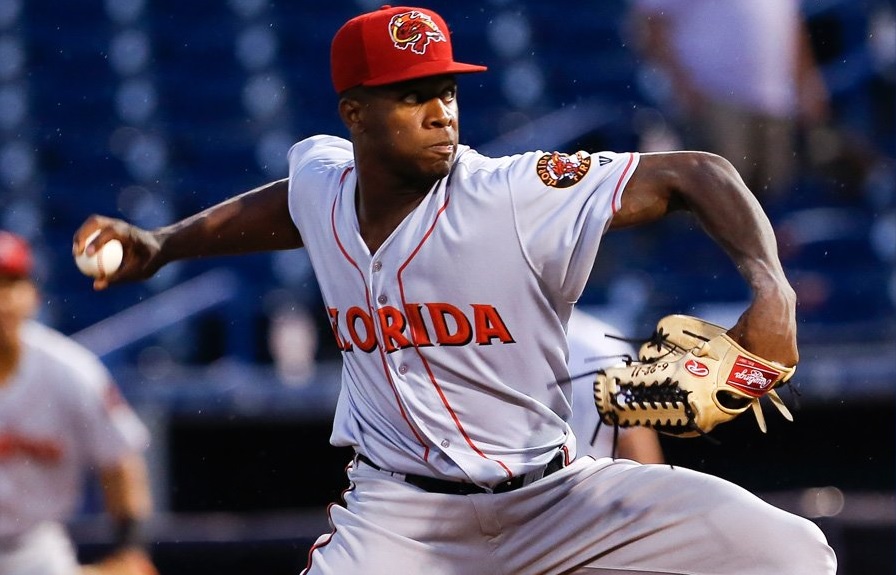
Andy Harris: That’s a tough one, because it actually really takes some work. First, you have to actually go to minor league games and watch the players, or at least get an MiLB.TV subscription so you can watch the games streaming over the interwebz. But even before that, you’ll need to read up on some scouting of the players you want to focus on. Taking Allard for example, it would be helpful to know going into the game what his pitching repertoire is. That way if you see “Allard has a plus curveball that is his main strikeout pitch” in the scouting reports, and you only see maybe four or five curveballs all night, you know Allard is working on something else. If you really have good rabbit ears, you’ll pick up snippets of information from pre- and post-game interviews. For example, Touki Toussaint told the Fire Frogs broadcast audience that he pitched from the stretch the entire month of June because he and his pitching coach wanted to focus on refining his command with runners on base.
Of course, the more you watch these guys, the more likely you are to notice when something is different. I don’t live too far from Rome, so I’m able to see them pretty regularly, and I saw a lot of Austin Riley last season. When I picked him up again in Florida, I noticed differences in his approach immediately because I had that context.
Micah Smith: I know you’ve traveled around to watch these guys play. Have you had a chance to interact with any of them personally? Any cool stories from the road?
Andy Harris: Nothing major, but a couple of fun things. I went up to Elizabethton, TN to see the Danville season opener, which was rained out and turned into a doubleheader the next day. About the third inning of the second game it started to rain. Most of the patrons started going undercover, but my son was having fun splashing on the now empty bleachers, and I was wet already, so I sat there and took it. Shortstop Derian Cruz was up to bat, and third baseman Nicholas Shumpert was on deck. I had seen Cruz play in Rome earlier in the season and he had been doing nothing at the plate but hit weak grounder after weak grounder. In these games though he was clearly trying to put some more loft on the ball. That led to mostly easy fly balls in the first game, but the second game he smacked a good hard double in the gap. In this at-bat he hit a loud line-drive that the center fielder had to make a really nice play on to get the out. I remarked to my son as he splashed by, “Well, at least he’s getting some good elevation on the ball now.” The bleachers being empty, my words must have carried to Nicholas Shumpert because he looked back at me with a little surprise, then grinned and said, “That’s right!”
Later on that game, the rain became a deluge, and I found myself under the pressbox with Kyle Muller and Jaret Hellinger, who had abandoned their posts charting the game. I ended up having a conversation with Muller about Joey Wentz and Riley Pint, who were slated to face each other in Asheville the next day.
Micah Smith: Awesome story. The closest I’ve gotten is yelling, “Good game Dansby!” after a game last year in AA. He looked up at me like I was weird and gave a little half wave….it was freaking awesome! Seriously, though, going to AA games at the nearby park, I pick up on a lot about these players that doesn’t usually make it into the stat sheets and highlight videos, such as body language and how they interact with other players between innings and in the dugout. I know one of the reasons I’m so high on Dansby Swanson is because of how he carried himself and interacted with others between innings and before and after games. Would you say these secondary factors influence your ratings? How? Any particular examples?
Andy Harris: Not too much, but I certainly note when those kinds of soft skills play out. One of the reasons I’ve been high on Albies was watching him interact with his teammates. This was especially true when I saw Albies last season early on with Mississippi. He was playing shortstop, and Camargo had been displaced to second base. As I was watching them warm up, you could just tell that they were just having a ball with each other; they were comfortable with each other. It could have been a situation where Albies would be the big hot shot prospect, or Camargo would be resentful for Albies taking a position that Camargo could play at least as well. But nope, they were playing catch and goofing off like they’ve been best friends forever. And Albies seems to have that effect on everyone.
I mention Kade Scivique before. He’s an old-school, take-charge catcher even though he’s only 24. I don’t think he’d be intimidated catching R.A. Dickey, or Max Scherzer, or John Smoltz.
Micah Smith: I guess with my psychology background, I love hearing about those interactions as much as reading the stat lines. It’s nice to remember these players are humans just like the rest of us. The Braves have one of the deepest farm systems in baseball so I’m sure there were some that just fell off the list who are quite good prospects. You’ve mentioned a few earlier, but let’s consolidate it and make it official: Who were your “next five,” with a quick blurb on each as to why you like them and why you decided to leave them just outside your top 30? (Just so you know, one of these guys better be Randy Ventura. I’ve had an odd obsession with him ever since I thought he might steal more bases than games played in the DSL (Note: he fell just short stealing 55 in 58 games) and he was doing it while showing some plate discipline.)
Andy Harris:
31: Izzy Wilson, OF, Rome. I spoke about him at length earlier.
32: Randy Ventura, OF, Rome. Here you go. He’s having a bit of a break-through at Rome with the bat. I like his hands and bat-to-ball skills a lot, but he’s not as fundamentally polished as Pache or as toolsy as Drew Waters. He’s very fast (and very distracting to opposing pitchers), but still needs to work on reading pitchers and his first step. In the outfield his speed really plays well and he has a surprisingly strong arm, but he sometimes loses focus and his route running is a little suspect.
33: Kade Scivicque, C, Mississippi. Again, I spoke about him earlier.
34: Abraham Gutierrez, C, GCL. Nothing really detracting, just a lack of data. I missed him when I went to the GCL, so I just don’t have as good a handle on him as others. Ranking here based almost completely on reporting by Ben Badler of Baseball America and Jeff Jones/@ProspectsBraves.
35: Freddy Tarnok, LHP, GCL. I love the film I see of this guy from high school, but like Gutierrez there’s an overall lack of data. He was the ball boy in the GCL game I saw, he did a nice job.
Micah Smith: That’s hilarious. At least he’ll have something to fall back on if the whole baseball playing thing doesn’t work out for him. To wrap up, we now have nearly three years of prospect development under the Hart/Coppy led rebuild. So let’s pretend the rebuild is a prospect in his third season. Using the scouting scale of 20-80, how would you rate the Front Office in the following five areas: acquiring pitching, acquiring hitting, developing pitching, developing hitting, and leveraging players at any level to improve the Braves system overall? [20 = so bad they have to start the rebuild over, and 80 = set up for another run like the 1990’s, only with more World Series wins.]
Andy Harris: Wow, that’s a cool question. OK…
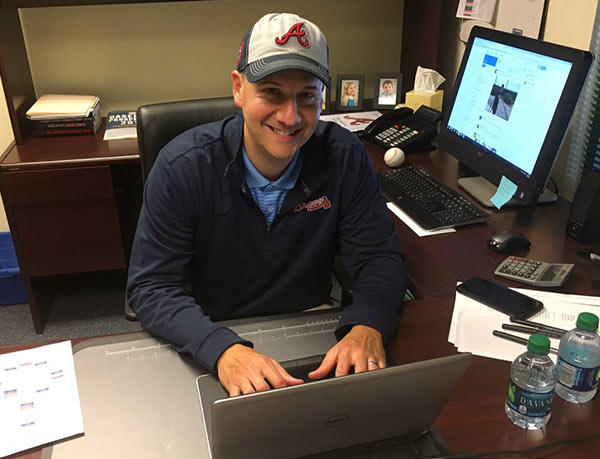
Acquiring pitching: 55 – several potential future All-Stars, possibly an ace or two, good trajectory on almost all high draft picks. Trades a little spottier, but at least one solid major league starter in Foltynewicz and another budding one in Newcomb. International mostly focused on hitters, but some interesting arms to be found, namely Yefri Del Rosario and Juan Contreras, about whom hardcore prospect hounds would probably beat me up after school if I didn’t at least mention.
Acquiring hitting: 50 – The two top position prospects were acquired before the rebuild, but savvy trading, extensive use of the international signing system, and making the most of the draft picks they have allotted to hitting have added to that foundation.
Developing pitching: 55 – I think Chuck Hernandez did a great job as the pitching coordinator last season and really established a good holistic pitching development program. Dave Wallace is back with the organization now, and that’s a good thing too. There’s some really good pitching coaches in the system, especially Dennis Llewellyn in Florida, who has been at this awhile, and Dan Meyer in Rome, who has not. Success stories are far outnumbering the disappointments so far.
Developing hitting: 60 – Since the rebuild, I think this has been the biggest improvement as far as development goes. When low-key international signings can go to be being top 20 prospects in AAA before the age of 20, something is going very right. I like the emphasis on keeping swings compact and controlled, allowing the hands to work, and being aggressive early in the count.
Leveraging players at any level to improve the Braves system overall: 45 – This is where I feel like the organization is a little bit at a crossroads. The major league team is finally having some success, playing around .500 ball and, unlike 2015, looking like they deserve to be there. There’s going to be a big temptation to start spending some of the prospect capital that the organization has accumulated. So far, the only prospects they’ve spent have been: Robert Whalen and Max Povse (for more prospects); Mallex Smith and Shae Simmons (for more prospects); John Gant, Chris Ellis, and Luke Dykstra (for Jaime Garcia); and Juan Yepez (for Matt Adams). None of those were top 10 prospects, but there will come a time when they’ll need to spend some top prospects to get another core piece of the next championship team. In the end, the rebuild will be judged on those decisions – who to keep, who to trade.
Micah Smith: I would be within a half grade of you on all of those. That last one is the trickiest to assess based on where we are in the rebuild. Like with a young power prospect not hitting many home runs, we’d say there are a lot of reasons to see strong potential to develop power with more advancement and maturity even if the results aren’t there yet. Same goes for the rebuild and leveraging players in trades. We have set ourselves up to make some really savvy moves to leverage prospects in order to fill key gaps on the MLB team. The question now is if we will actually make savvy moves, and on that, the jury is still out.
Micah Smith: Thanks Andy. I always enjoy discussing prospects with you and reading your analysis of prospects and the system, especially during these exciting days of a farm system flush with talent.
Andy Harris: Thanks Micah, this was fun!



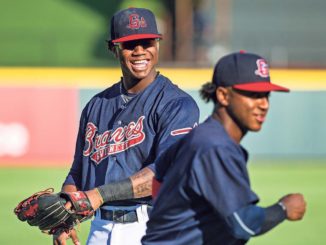
Leave a Reply